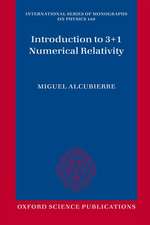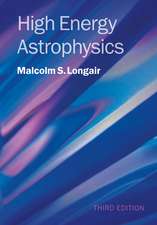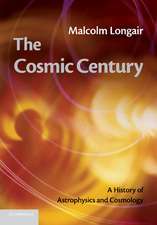Eruptive Solar Flares: Proceedings of Colloquium No. 133 of the International Astronomical Union Held at Iguazú, Argentina, 2–6 August 1991: Lecture Notes in Physics, cartea 399
Editat de Zdenek Svestka, Bernard V. Jackson, Marcos E. Machadoen Limba Engleză Paperback – 20 noi 2013
Din seria Lecture Notes in Physics
- 19%
 Preț: 424.00 lei
Preț: 424.00 lei - 17%
 Preț: 360.73 lei
Preț: 360.73 lei -
 Preț: 429.22 lei
Preț: 429.22 lei - 17%
 Preț: 427.62 lei
Preț: 427.62 lei - 17%
 Preț: 460.26 lei
Preț: 460.26 lei -
 Preț: 427.96 lei
Preț: 427.96 lei -
 Preț: 481.93 lei
Preț: 481.93 lei - 17%
 Preț: 494.66 lei
Preț: 494.66 lei -
 Preț: 281.90 lei
Preț: 281.90 lei - 17%
 Preț: 493.20 lei
Preț: 493.20 lei - 17%
 Preț: 426.72 lei
Preț: 426.72 lei -
 Preț: 365.15 lei
Preț: 365.15 lei -
 Preț: 374.52 lei
Preț: 374.52 lei -
 Preț: 407.98 lei
Preț: 407.98 lei - 20%
 Preț: 428.13 lei
Preț: 428.13 lei -
 Preț: 263.30 lei
Preț: 263.30 lei - 15%
 Preț: 593.73 lei
Preț: 593.73 lei - 15%
 Preț: 528.13 lei
Preț: 528.13 lei -
 Preț: 493.12 lei
Preț: 493.12 lei - 17%
 Preț: 425.68 lei
Preț: 425.68 lei -
 Preț: 280.65 lei
Preț: 280.65 lei -
 Preț: 163.41 lei
Preț: 163.41 lei - 18%
 Preț: 726.59 lei
Preț: 726.59 lei -
 Preț: 394.84 lei
Preț: 394.84 lei - 15%
 Preț: 709.63 lei
Preț: 709.63 lei - 15%
 Preț: 623.90 lei
Preț: 623.90 lei - 20%
 Preț: 476.93 lei
Preț: 476.93 lei - 15%
 Preț: 428.05 lei
Preț: 428.05 lei -
 Preț: 342.78 lei
Preț: 342.78 lei - 18%
 Preț: 851.93 lei
Preț: 851.93 lei -
 Preț: 346.61 lei
Preț: 346.61 lei -
 Preț: 391.57 lei
Preț: 391.57 lei - 15%
 Preț: 633.16 lei
Preț: 633.16 lei -
 Preț: 451.71 lei
Preț: 451.71 lei - 5%
 Preț: 1497.80 lei
Preț: 1497.80 lei -
 Preț: 374.85 lei
Preț: 374.85 lei -
 Preț: 380.07 lei
Preț: 380.07 lei - 15%
 Preț: 516.14 lei
Preț: 516.14 lei - 15%
 Preț: 583.78 lei
Preț: 583.78 lei - 15%
 Preț: 508.60 lei
Preț: 508.60 lei -
 Preț: 469.73 lei
Preț: 469.73 lei -
 Preț: 388.90 lei
Preț: 388.90 lei - 15%
 Preț: 500.24 lei
Preț: 500.24 lei -
 Preț: 386.52 lei
Preț: 386.52 lei - 15%
 Preț: 472.88 lei
Preț: 472.88 lei -
 Preț: 424.27 lei
Preț: 424.27 lei -
 Preț: 380.07 lei
Preț: 380.07 lei - 15%
 Preț: 500.01 lei
Preț: 500.01 lei
Preț: 649.54 lei
Preț vechi: 764.17 lei
-15% Nou
Puncte Express: 974
Preț estimativ în valută:
124.31€ • 129.30$ • 102.62£
124.31€ • 129.30$ • 102.62£
Carte tipărită la comandă
Livrare economică 14-28 aprilie
Preluare comenzi: 021 569.72.76
Specificații
ISBN-13: 9783662138748
ISBN-10: 3662138743
Pagini: 424
Ilustrații: XIV, 409 p. 94 illus.
Dimensiuni: 170 x 244 x 22 mm
Greutate: 0.67 kg
Ediția:Softcover reprint of the original 1st ed. 1992
Editura: Springer Berlin, Heidelberg
Colecția Springer
Seria Lecture Notes in Physics
Locul publicării:Berlin, Heidelberg, Germany
ISBN-10: 3662138743
Pagini: 424
Ilustrații: XIV, 409 p. 94 illus.
Dimensiuni: 170 x 244 x 22 mm
Greutate: 0.67 kg
Ediția:Softcover reprint of the original 1st ed. 1992
Editura: Springer Berlin, Heidelberg
Colecția Springer
Seria Lecture Notes in Physics
Locul publicării:Berlin, Heidelberg, Germany
Public țintă
ResearchCuprins
History and basic characteristics of eruptive flares.- Basic magnetic configuration and energy supply processes for an interacting flux model of eruptive solar flares.- The role of cancelling magnetic fields in the buildup to erupting filaments and flares.- Variation of the vector magnetic field in an eruptive flare.- Intrinsically hot flares and a possible connection to deep convective magnetic fields.- Interaction of large-scale magnetic structures in solar flares.- The intrinsic relationship between flares and eruption of filament currents.- Filament eruptions, flaring arches and eruptive flares.- MHD non-equilibrium: A numerical experiment.- Triggering of eruptive flares: Destabilization of the preflare magnetic field configuration.- Field opening and reconnection.- Energy release at Alfvénic fronts in a force-free magnetic flux tube.- Energy transport in solar flares: Implications for Ca XIX emission.- Fluid flow in a jet and the CA XIX line profiles observed during solar flares.- Characteristics of the impulsive phase of flares.- Comparison of UV and X-ray solar flare observations and theoretical models.- White-light flares.- “Post” flare loops.- Plasma parameters derived from MSDP observations of cool flare loops.- Flare evolution in the density temperature diagram.- The Neupert Effect: What can i tell us about the impulsive and gradual phases of eruptive flares?.- Particle acceleration in the impulsive phase of solar flares.- Kinetic description of electron beams in the chromosphere.- Nuclear reactions in flares.- Radio emission of eruptive flares.- Arcsecond determination of solar burst centers of emission simultaneous to high time resolution and high sensitivity at 48 GHz.- Trapping and escape of the high energy particles responsible for major protonevents.- Coronal and interplanetary transport of solar flare protons from the ground level event of 29 september 1989.- High energetic solar proton flares of 19 to 29 October 1989.- Large-scale quasi-stationary X-ray coronal structures associated with eruptive solar flares.- Large scale structures associated with eruptive flares and radio waves.- Coronal millimeter sources associated with eruptive flares.- On the association between large scale X-ray brightenings and solar flares.- A giant post-flare coronal arch observed by Skylab.- Characteristics of coronal mass ejections.- The solar sources of coronal mass ejections.- Remote sensing observations of mass ejections and shocks in interplanetary space.- In situ observations of coronal mass ejections in interplanetary space.- Meter-decameter radio emission associated with a coronal mass ejection.- Models of normal and inverse polarity filament eruptions and coronal mass ejections.- MHD shocks and simple waves in CMES.- Terrestrial response to eruptive solar flares: Geomagnetic storms.- Stellar flares: Confined or eruptive events?.- Radio flare emission from late-type stars.- The Solar-A mission experiments and the targets.- Nobeyama radioheliograph.- Decimeter high resolution solar radio spectroscope.- Considerations of a Solar Mass Ejection Imager in a low-earth orbit.- An Observational-conceptual model of the formation of filaments.- Dynamics in the prominence-corona transition region from HRTS spectra.- Active region classifications, complexity, and flare rates.- Compact sources of suprathermal microwave emission detected in quiescent active regions during lunar occulatations.- Velocity field in the 13 June 1980 flare area.- Deformation of magnetic null points.- The X12 limb flare and spray of 01 June 1991.- Analysisof X-ray flares observed by the SMM spacecraft.- Distribution function for electron beams in the chromosphere.- Sub-second variations of HXR and H-alpha flare emission.- The role of protons in solar flares.- High spectral resolution of MM-wavelength (23 – 18 GHz) solar bursts.- Microwave flare characteristics in 8 and 3 mm Metsähovi measurements compared with optical and H-alpha data.- Simultaneous H? and microwave observations of a limb flare on June 20, 1989.- Nonresonant ion-beam turbulence in solar flares.- Nonlinear emission mechanism of type III solar radio bursts.- A numerical simulation of magnetically driven coronal mass ejections.- Coronal mass ejections: The link between solar and geomagnetic activity.- A study of geomagnetic variations with periods of four years, six months and 27 days.- Atmospheric models of flare stars.- The emerging picture of eruptive solar flares.
















